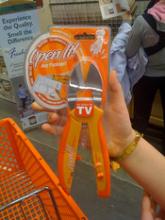Plastic clamshell cases: You know them; you hate them. They are impossible to open without at the very least a pair of scissors. The last time I was presented with one, I gave up trying to cut it with scissors, and resorted to using a serrated bread knife to slice off the top.
Those big showy cases have two purposes: they show off the goods, and they help prevent sneaky shoplifters from stealing the item out of the package and returning it to the shelf.
(Or so we are told, anyway. Does this really work? I remember when CDs started coming in giant cardboard boxes back in the late 1980s. We were told it was to prevent theft. But people just folded the big boxes in half and stuck the whole thing down their pants.
Obviously the big boxes were just to co-opt more shelf space and provide more surface area for branding. I don't half suspect the same thing is happening with plastic packages. Every square inch bigger you make your clamshell pack, is one less square inch that your competitor's product can claim on the shelf.)
Neither display nor theft prevention is an issue for Amazon, of course. And yet, most products ship from Amazon in the same package you'd buy at the store. Now Amazon is working to stop this practice, with its new "frustration-free packaging" movement.
Frustration-free packaging is a win for everyone involved. The New York Times points out that when Philips designed frustration-free packaging for its Essence electronic toothbrush it saved money, got better customer reviews (because people could open the dang box), and reduced its carbon footprint because the new packaging was recyclable.
Ever since I moved to my current home, I have become exquisitely attuned to the volume of trash we buy every day in the form of packaging. Why? Because I live beyond the range of garbage pick-up, so I have to take my trash to the dump. Believe me, when you start having to pay by the pound for your own trash, not to mention hauling it all out there yourself, you start noticing these things.
I never noticed packaging when I lived in apartments, because you just take the trash out whenever you like. Just drop it down a chute, or toss it into a dumpster, and you have no idea how much you're really generating. But once you start trying to go on a "trash diet," the first thing you notice is that at least 75% of your garbage is just the stuff your stuff came in.
In fact, I'm so excited about this frustration-free packaging that I'm thinking about buying things through Amazon that I normally wouldn't. For example, Duracell sells its batteries in the store in clamshells… but if you buy them through Amazon, they come in a recyclable cardboard box. Hallelujah!
The two biggest problems with packaging is their manufacture (made from petroleum; chemicals, shipping, etc) and their disposal (almost no plastic packaging can be recycled). Vote with your debit card, and start encouraging companies to offer frustration-free packaging through Amazon!
Those big showy cases have two purposes: they show off the goods, and they help prevent sneaky shoplifters from stealing the item out of the package and returning it to the shelf.
(Or so we are told, anyway. Does this really work? I remember when CDs started coming in giant cardboard boxes back in the late 1980s. We were told it was to prevent theft. But people just folded the big boxes in half and stuck the whole thing down their pants.
Obviously the big boxes were just to co-opt more shelf space and provide more surface area for branding. I don't half suspect the same thing is happening with plastic packages. Every square inch bigger you make your clamshell pack, is one less square inch that your competitor's product can claim on the shelf.)
Neither display nor theft prevention is an issue for Amazon, of course. And yet, most products ship from Amazon in the same package you'd buy at the store. Now Amazon is working to stop this practice, with its new "frustration-free packaging" movement.
Frustration-free packaging is a win for everyone involved. The New York Times points out that when Philips designed frustration-free packaging for its Essence electronic toothbrush it saved money, got better customer reviews (because people could open the dang box), and reduced its carbon footprint because the new packaging was recyclable.
Ever since I moved to my current home, I have become exquisitely attuned to the volume of trash we buy every day in the form of packaging. Why? Because I live beyond the range of garbage pick-up, so I have to take my trash to the dump. Believe me, when you start having to pay by the pound for your own trash, not to mention hauling it all out there yourself, you start noticing these things.
I never noticed packaging when I lived in apartments, because you just take the trash out whenever you like. Just drop it down a chute, or toss it into a dumpster, and you have no idea how much you're really generating. But once you start trying to go on a "trash diet," the first thing you notice is that at least 75% of your garbage is just the stuff your stuff came in.
In fact, I'm so excited about this frustration-free packaging that I'm thinking about buying things through Amazon that I normally wouldn't. For example, Duracell sells its batteries in the store in clamshells… but if you buy them through Amazon, they come in a recyclable cardboard box. Hallelujah!
The two biggest problems with packaging is their manufacture (made from petroleum; chemicals, shipping, etc) and their disposal (almost no plastic packaging can be recycled). Vote with your debit card, and start encouraging companies to offer frustration-free packaging through Amazon!
Photo credit: Flickr/Hendel
